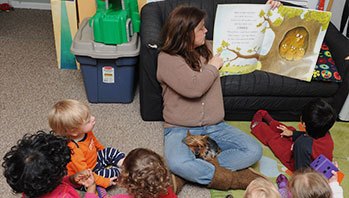- chart paper
- marker
- sink with a faucet
- drop
- flow
- wet
MA Standards:
Reading for Informational Text/RI.P.MA.1: With prompting and support, ask and answer questions about an informational text read aloud.
Reading for Informational Text/RI.P.MA.2: With prompting and support, recall important facts from an informational text after hearing it read aloud.
Reading for Informational Text/RI.P.MA.4: With prompting and support, ask and answer questions about unfamiliar words in an informational text read aloud.
Reading for Informational Text/RI.P.MA.10: Listen actively as an individual and as a member of a group to a variety of age-appropriate informational texts read aloud.
Head Start Outcomes:
Literacy Knowledge/Book Appreciation and Knowledge: Asks and answers questions and makes comments about print materials.
Science Knowledge/Scientific Skills and Method: Uses senses and tools, including technology, to gather information, investigate materials, and observe processes and relationships.
PreK Learning Guidelines:
English Language Arts/Reading and Literature 6: Listen to a wide variety of age appropriate literature read aloud.
English Language Arts/Reading and Literature 10: Engage actively in read-aloud activities by asking questions, offering ideas, predicting or retelling important parts of a story or informational book.
Read Together: I Get Wet #2

© Commonwealth of Massachusetts, Department of Early Education and Care (Jennifer Waddell photographer). All rights reserved.
STEM Key Concepts: When water flows very slowly, it can start to drip; Water drops stick together
ELA Focus Skills: Listening and Speaking, Genre, Story Comprehension (Making Connections), Vocabulary
Educator Note: This book is designed to be read in segments, allowing children to do the activities described in each section before turning to subsequent pages, a process that reinforces the discoveries they make (see “Note to the Reader” in the beginning of the book). The activity below focuses on the second activity in the book (Why does water flow?), but you may choose to focus on another activity depending on what children are noticing in their explorations.
Before You Read
Display the cover of I Get Wet. Ask children to locate the title. Track the words as you read the title aloud and then have children read it with you. Point to and read the names of the author and illustrator. Review the discussion from last week about the cover of the book as you ask, What did the illustrator draw around the title of the book? Why do you think she did that? Guide children to conclude that the water drop and the words in the title are clues that this book is about water.
As You Read
Hold up the book so children can see the illustrations as you read. Read the first two page spreads, and then tell children that you are going to skip over to the second activity because it is about water drops. Ask children to describe what they see in the picture. (boy getting a glass of water from a faucet to drink)
- Remind children that they read another book where children were drinking water out of a faucet. Help children make a connection to the book A Cool Drink of Water, which they read earlier in the week. Then ask, Can you describe the way water comes out of the faucet? Encourage them to use the words flow and drip.
- Read the text on the spread and tell children they are going to do the activity in the book to find out why water flows.
Gather children around a faucet, and follow the activity as the text describes. Then read the next page following this activity (“Watch as a drop of water comes out of the faucet. . . .”) to help children understand that water can flow because it sticks to itself and that when it flows out of the faucet slowly it forms a drop.
After You Read
Talk with children about what they observed and why. Ask children to describe what they learned and to answer questions such as,
- Why does water flow?
- What did you notice about a water drop as it came out of the faucet? Can you describe what it looks like?
- How do you know water sticks to itself?
Take It Further: Have children explore how water drops stick together while using their eyedroppers.
